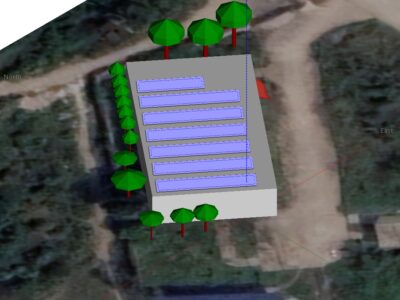Site 2.35

Site ID
2.35
Health

COD
2016
Nominal Capacity
20 kWp
Average Specific Yield
1331 kWh/kWp
Total Estimated Loss
22.03%
Possible Gain
6% to 13%
CAPEX, OPEX
5.24 ₹/Wp, 1.30 ₹/Wp/a
Expenditure / Energy
19.7 ₹/kWh to 9.3 ₹/kWh
Abstract
Loosely hanging cables with low bending radius were found. Modules with burn marks on cell fingers and damaged frame were found. It is recommended to (i) optimize the cable layout, (ii) replace damaged modules and re-sort lower performing modules, (iii) relocate the corner tables, (iv) retrofit the mounting structure, (v) add module to module equipotential bonding, and (vi) install a weather station or at least an irradiation sensor on the module plane. The estimated production boost expected by the retrofitting actions lies between 6% and 12.7%.
Main Findings
Poor cable management: Loosely hanging cables. Missing string labelling at the module end. Connectors are degraded.
Modules with burn marks on cell fingers, damaged frame, and cell delamination found.
Module to module equipotential bonding missing.
Improper roof access. No safety railings on the installation area.
Module misalignment due to posts in structure not parallel to each other.
Structure purlins not parallel to each other due to factory or handling damage.
Screws used in structure are rusted.
Front row modules are installed on roof edge without a parapet wall to reduce the wind flow.
Modules shaded poles placed next to modules on site.
No weather station found on site.
Impact on Performance
Heavy Soiling
IR analysis reveals presence of hot cells and hotspots, due to soiling and presence of isolated cell parts. Based on the IV curve measurements, the soiling loss is estimated to be 9.7%.
Estimated Loss
≈ 9.7%
Cell Cracks
The EL image reveals presence of cracks and isolated parts indicating issues from transportation or handling. These defects generate hotspots and pose both performance and safety threat.
Estimated Loss
≈ 8%
Underperformance
Based on the IV curve measurements, the estimated underperformance is 2.3% for the measured modules.
Estimated Loss
≈ 2.3%
Near Shading
According to PVsyst simulation, the near shading losses account to 1.48%.
Estimated Loss
≈ 1.48%
Total Estimated Energy Loss
≈ 22.03%
Proposed Solutions
Strings, tables, and inverters should have a suitable labelling (UV-resistant).
The cleaning cycles shall be increased based on the results of a soiling study.
Damaged modules shall be replaced to reduce further performance loss.
Module to module earthing connections shall be added.
Safety railings and a better roof access shall be provided if possible for safer and easier O&M activity.
A re-sorting shall be conducted to have lower performing modules in the same string or at least assigned to individual MPPT.
A weather station, or at least an irradiation sensor on the module plane shall be installed.
Tables shall be moved away from the roof edge to prevent damage from higher wind loads.
Rusted components of the structure shall be replaced if possible. To prevent such problems, metal objects vulnerable to corrosion can be painted with zinc. The vertical posts and purlins used in the structure shall be replaced to restore structure functionality and reduce module misalignment.
Poles causing shading shall be relocated to reduce shading impact.













